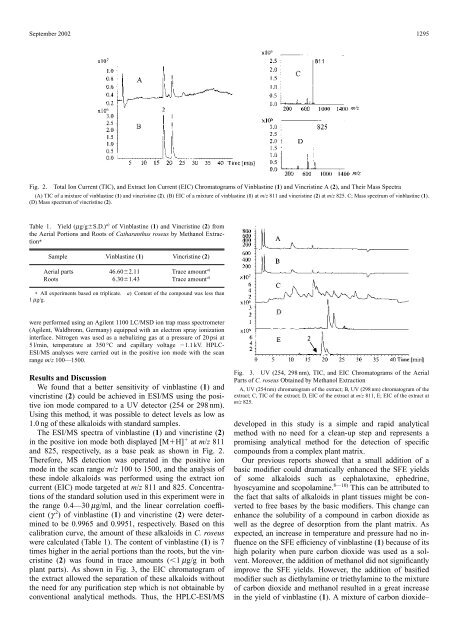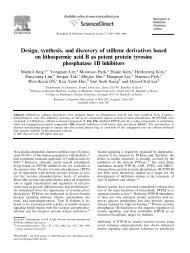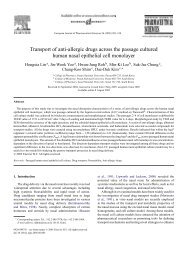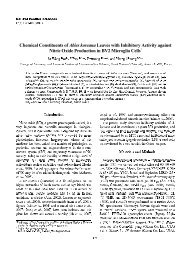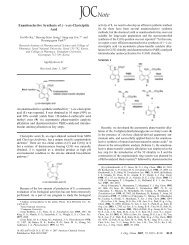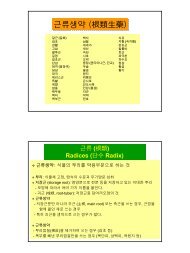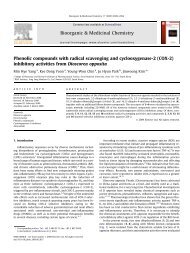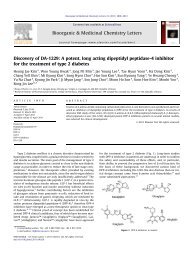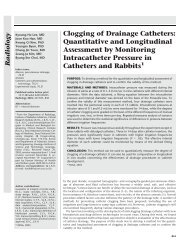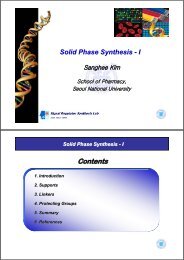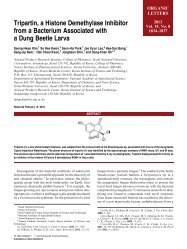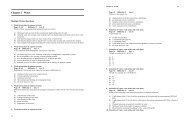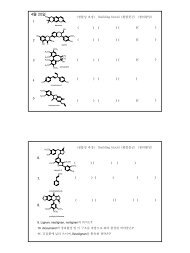Supercritical Fluid Extraction and Liquid Chromatography ...
Supercritical Fluid Extraction and Liquid Chromatography ...
Supercritical Fluid Extraction and Liquid Chromatography ...
Create successful ePaper yourself
Turn your PDF publications into a flip-book with our unique Google optimized e-Paper software.
September 2002 1295<br />
Fig. 2.<br />
Total Ion Current (TIC), <strong>and</strong> Extract Ion Current (EIC) Chromatograms of Vinblastine (1) <strong>and</strong> Vincristine A (2), <strong>and</strong> Their Mass Spectra<br />
(A) TIC of a mixture of vinblastine (1) <strong>and</strong> vincristine (2). (B) EIC of a mixture of vinblastine (1) at m/z 811 <strong>and</strong> vincristine (2) at m/z 825. C; Mass spectrum of vinblastine (1).<br />
(D) Mass spectrum of vincristine (2).<br />
Table 1. Yield (mg/gS.D.) a) of Vinblastine (1) <strong>and</strong> Vincristine (2) from<br />
the Aerial Portions <strong>and</strong> Roots of Catharanthus roseus by Methanol <strong>Extraction</strong>*<br />
Sample Vinblastine (1) Vincristine (2)<br />
Aerial parts 46.602.11 Trace amount a)<br />
Roots 6.301.43 Trace amount a)<br />
∗ All experiments based on triplicate.<br />
1 mg/g.<br />
a) Content of the compound was less than<br />
were performed using an Agilent 1100 LC/MSD ion trap mass spectrometer<br />
(Agilent, Waldbronn, Germany) equipped with an electron spray ionization<br />
interface. Nitrogen was used as a nebulizing gas at a pressure of 20 psi at<br />
5 l/min, temperature at 350 °C <strong>and</strong> capillary voltage 1.1 kV. HPLC-<br />
ESI/MS analyses were carried out in the positive ion mode with the scan<br />
range m/z 100—1500.<br />
Results <strong>and</strong> Discussion<br />
We found that a better sensitivity of vinblastine (1) <strong>and</strong><br />
vincristine (2) could be achieved in ESI/MS using the positive<br />
ion mode compared to a UV detector (254 or 298 nm).<br />
Using this method, it was possible to detect levels as low as<br />
1.0 ng of these alkaloids with st<strong>and</strong>ard samples.<br />
The ESI/MS spectra of vinblastine (1) <strong>and</strong> vincristine (2)<br />
in the positive ion mode both displayed [MH] at m/z 811<br />
<strong>and</strong> 825, respectively, as a base peak as shown in Fig. 2.<br />
Therefore, MS detection was operated in the positive ion<br />
mode in the scan range m/z 100 to 1500, <strong>and</strong> the analysis of<br />
these indole alkaloids was performed using the extract ion<br />
current (EIC) mode targeted at m/z 811 <strong>and</strong> 825. Concentrations<br />
of the st<strong>and</strong>ard solution used in this experiment were in<br />
the range 0.4—30 mg/ml, <strong>and</strong> the linear correlation coefficient<br />
(g 2 ) of vinblastine (1) <strong>and</strong> vincristine (2) were determined<br />
to be 0.9965 <strong>and</strong> 0.9951, respectively. Based on this<br />
calibration curve, the amount of these alkaloids in C. roseus<br />
were calculated (Table 1). The content of vinblastine (1) is 7<br />
times higher in the aerial portions than the roots, but the vincristine<br />
(2) was found in trace amounts (1 mg/g in both<br />
plant parts). As shown in Fig. 3, the EIC chromatogram of<br />
the extract allowed the separation of these alkaloids without<br />
the need for any purification step which is not obtainable by<br />
conventional analytical methods. Thus, the HPLC-ESI/MS<br />
Fig. 3. UV (254, 298 nm), TIC, <strong>and</strong> EIC Chromatograms of the Aerial<br />
Parts of C. roseus Obtained by Methanol <strong>Extraction</strong><br />
A, UV (254 nm) chromatogram of the extract; B, UV (298 nm) chromatogram of the<br />
extract; C, TIC of the extract; D, EIC of the extract at m/z 811, E; EIC of the extract at<br />
m/z 825.<br />
developed in this study is a simple <strong>and</strong> rapid analytical<br />
method with no need for a clean-up step <strong>and</strong> represents a<br />
promising analytical method for the detection of specific<br />
compounds from a complex plant matrix.<br />
Our previous reports showed that a small addition of a<br />
basic modifier could dramatically enhanced the SFE yields<br />
of some alkaloids such as cephalotaxine, ephedrine,<br />
hyoscyamine <strong>and</strong> scopolamine. 8—10) This can be attributed to<br />
the fact that salts of alkaloids in plant tissues might be converted<br />
to free bases by the basic modifiers. This change can<br />
enhance the solubility of a compound in carbon dioxide as<br />
well as the degree of desorption from the plant matrix. As<br />
expected, an increase in temperature <strong>and</strong> pressure had no influence<br />
on the SFE efficiency of vinblastine (1) because of its<br />
high polarity when pure carbon dioxide was used as a solvent.<br />
Moreover, the addition of methanol did not significantly<br />
improve the SFE yields. However, the addition of basified<br />
modifier such as diethylamine or triethylamine to the mixture<br />
of carbon dioxide <strong>and</strong> methanol resulted in a great increase<br />
in the yield of vinblastine (1). A mixture of carbon dioxide–


